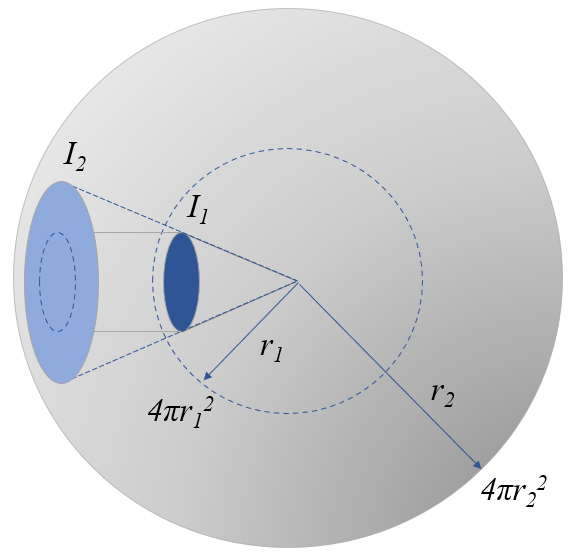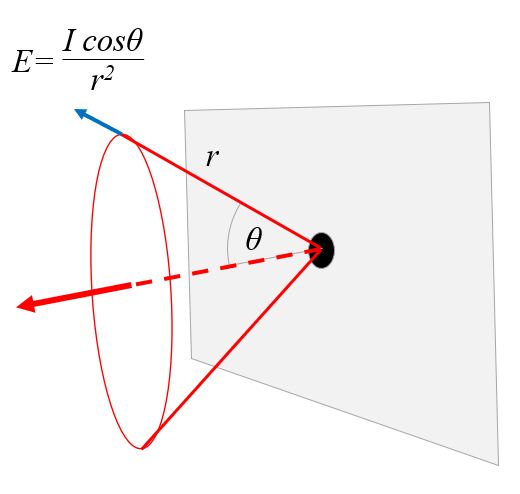Emisión de una fuente puntual
Storyboard 
The propagation of light in a homogeneous medium occurs rectilinearly at a characteristic speed that depends on both the medium and the frequency (color) of the light.
Propagation can be described both as a corpuscular model, in which the particles are called photons, as a wave model.
ID:(300, 0)
Light
Image 
Light is an electromagnetic wave with a wavelength \lambda that falls within the range of 380 nm to 750 nm, encompassing the visible spectrum that our eyes can perceive.

Light propagates in a straight line and can undergo refraction, meaning it can be deviated, if the speed of light changes due to the medium it passes through.
ID:(408, 0)
Propagation of light in a straight line and in a spherical shape
Image 
Light travels in a straight line and radiates spherically around its source.

Because of this spherical distribution, its intensity decreases with distance from the source.
ID:(12677, 0)
Non-uniform emission: orifice
Image 
When light passes through an aperture, it does not propagate uniformly but instead exhibits a distribution, creating what is known as a penumbra.

ID:(12679, 0)
Model
Top 
Parameters
Variables
Calculations
Calculations
Calculations
Equations
\Delta\Phi = I \Delta\Omega
DPhi = I * Domega
I_2 =\displaystyle\frac{ r_1 ^2}{ r_2 ^2} I_1
I_2 = r_2 ^2 * I_1 / r_1 ^2
\Phi =\displaystyle\int I d \Omega
Phi =@INT( I , Omega )
E=\displaystyle\frac{I\cos\theta}{r^2}
E=I*cos(theta)/r^2
ID:(16081, 0)
Reduction in intensity with distance
Equation 
If light emits in all directions uniformly, it will distribute itself evenly over the surface of an imaginary sphere with an area of
4\pi r^2
Hence, if we know its intensity at a distance r_1, we can predict its intensity at a distance r_2 using
Since the amount of light is conserved, the intensity (energy per area) multiplied by the area must be a constant, which leads us to the following relationship:
4\pi r_1^2I_1=4\pi r_2^2I_2
Therefore, we can express the relationship between intensities at different distances as:
| I_2 =\displaystyle\frac{ r_1 ^2}{ r_2 ^2} I_1 |
ID:(12678, 0)
Flow
Equation 
Radiative flux (\Phi) is calculated from the intensity (
and it is measured in watts (W).
In the context where flux is evaluated with respect to the human eye's ability to perceive luminous power, it is expressed in the unit of lumens (lm).
ID:(464, 0)
Total flow
Equation 
Since the flux through an element of angle d\Omega is defined as
| \Delta\Phi = I \Delta\Omega |
the total flux is obtained by integrating the intensity over the entire surface, as shown in the following expression:
Si se quiere conocer el flujo total se debe sumar sobre toda la superficie. Esto es se debe integrar (=sumar) sobre toda la superficie de modo de
| \Delta\Phi = I \Delta\Omega |
lo que arroja
| \Phi =\displaystyle\int I d \Omega |
Some examples of total flux include:
Source | Flux
High-Pressure Xenon Lamp | 3.0E+6 lm
Arc Lamp | 1.0E+4 lm
65W Fluorescent Lamp | 3.3E+3 lm
60W Bulb | 6.2E+2 lm
ID:(138, 0)
Irradiance
Equation 
When radiation with intensity
is measured in Lux (lx), which corresponds to one lumen per square meter.
For natural light, the following values can be used as reference:
Scenario Irradiance
Noon, summer, sunny 1.0E+5 lx
Noon, summer, cloudy 2.0E+4 lx
Noon, winter, sunny 1.0E+4 lx
Noon, winter, cloudy 2.0E+3 lx
ID:(8601, 0)
